Black thrips, or chili thrips, are a major pest of chili pepper plants and other crops. They are tiny insects that belong to the family Thripidae. These pests are known for damaging various crops, including chili pepper plants. Scientifically classified as Scirtothrips dorsalis, black thrips are native to South and Southeast Asia but have spread to other parts of the world, including Africa, North and South America, and Australia.
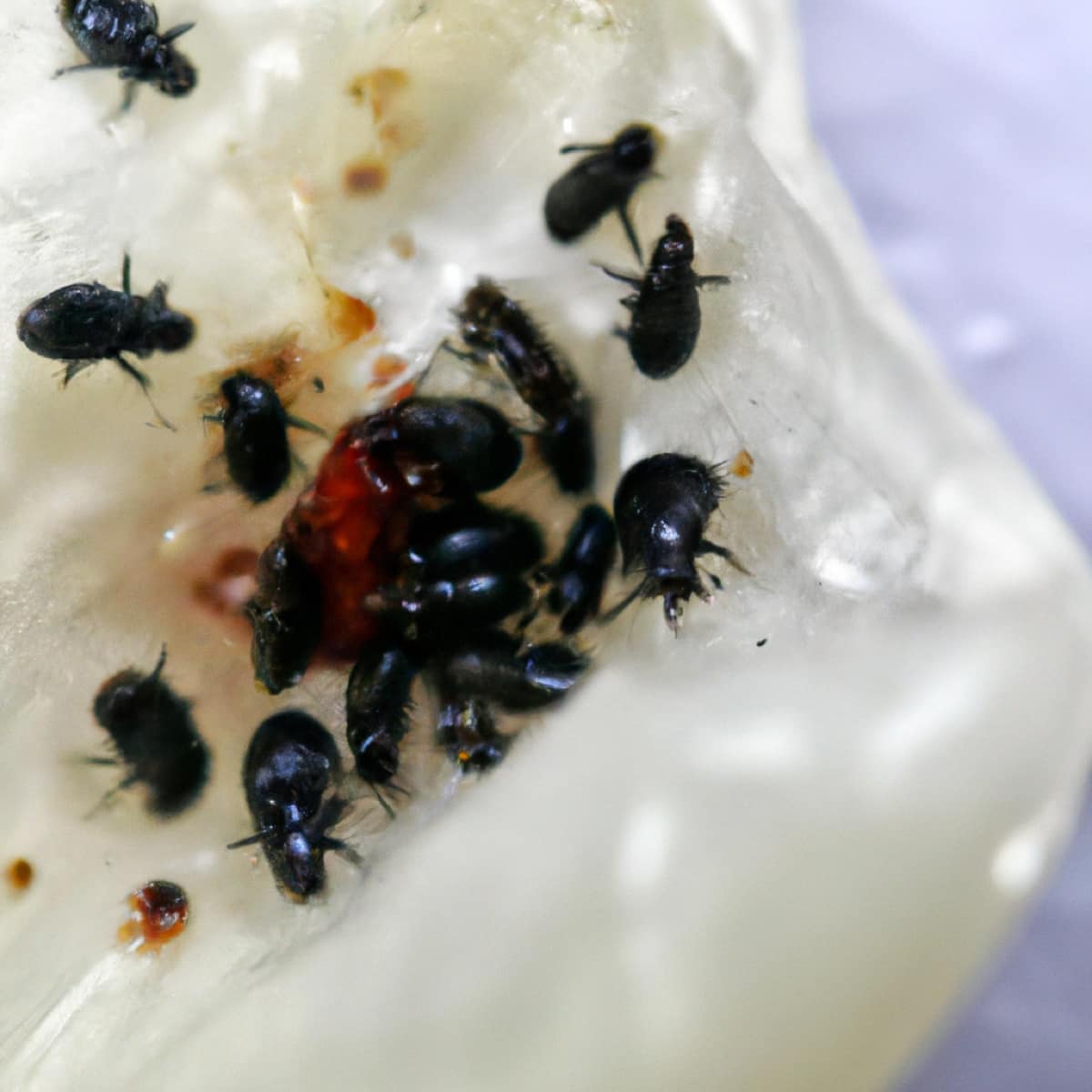
They are brownish-black in color and about 1-2 mm in length. Black thrips feed on the leaves and fruits of chili plants, causing leaf curling, stunted growth, and reduced yield. They also transmit viruses that can cause further damage to the plants. Black thrips control requires cultural, physical, and chemical methods.
Culturally controlled methods include crop management, infected plant removal, and resistant chili types. Sticky traps, insect screens, and reflective mulches have insects. Insecticides should be used carefully to avoid harming beneficial insects and the ecosystem. Effective black thrips management requires monitoring and early finding.
Management of Black Thrips in Chilli Peppers
Identification of Black Thrips in Chilli
- Black thrips are small insects, about 1-2 mm in length, and are brownish-black in color.
- Adults and nymphs of black thrips feed on tender leaves and growing shoots, causing leaf curling and stunted growth.
- Two species of thrips, Scirtothrips dorsalis and Rhipiphorothrips cruentatus can cause these symptoms.
- Scirtothrips dorsalis adults are straw yellow and lay about 50 grayish-white bean-shaped eggs, usually inside young leaves and buds. The nymphs are reddish, then turn yellowish-brown.
- Rhipiphorothrips cruentatus adults are blackish brown with yellowish wings, about 1.4mm long, and have heavily fringed wings.
- Nymphs of both species drop off the plant and complete their development in loose soil or leaf litter at the base of their host.
In case you missed it: Chilli Fertilizer Schedule: How and When to Apply Organically, Inorganically for More Yields
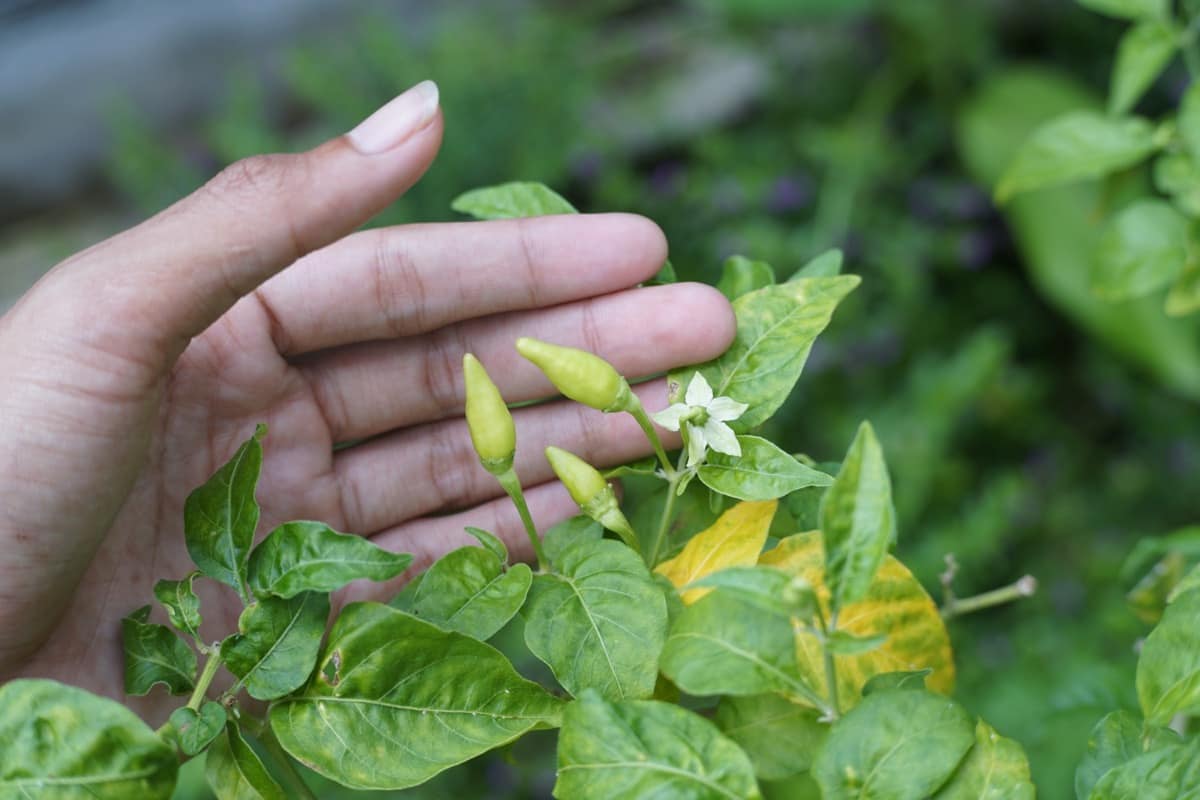
The Life Cycle of Black Thrips in Chilli
- The life cycle of black thrips, also known as chili thrips, is similar to that of other thrips species.
- Females insert their eggs inside plant tissue, where they hatch in 6-8 days.
- The larvae pass through two stages, consuming enough food to complete development to the adult stage.
- The Fully-grown larvae molt into a prepupal stage, lasting up to 24 hours, and then pupate on the soil.
- The pupal stage lasts 2-3 days before the adult emerges.
- The entire life cycle can be completed in 12-22 days, with females laying 60-200 eggs in their lifetime.
- As populations expand, they will also select the mature leaf surface. The duration of incubation is 3 to 8 days.
Conditions Favorable for Black Thrips Spread in the Field
- Warm temperatures between 20-35°C favor the growth and reproduction of black thrips.
- Humid conditions, particularly high humidity above 60%, promote their development and spread.
- Weeds and other host plants can serve as a reservoir for black thrips, allowing them to spread to nearby crops.
In case you missed it: Leaf Curl Virus in Chilli Crop: Symptoms, Causes, Control, and Treatment
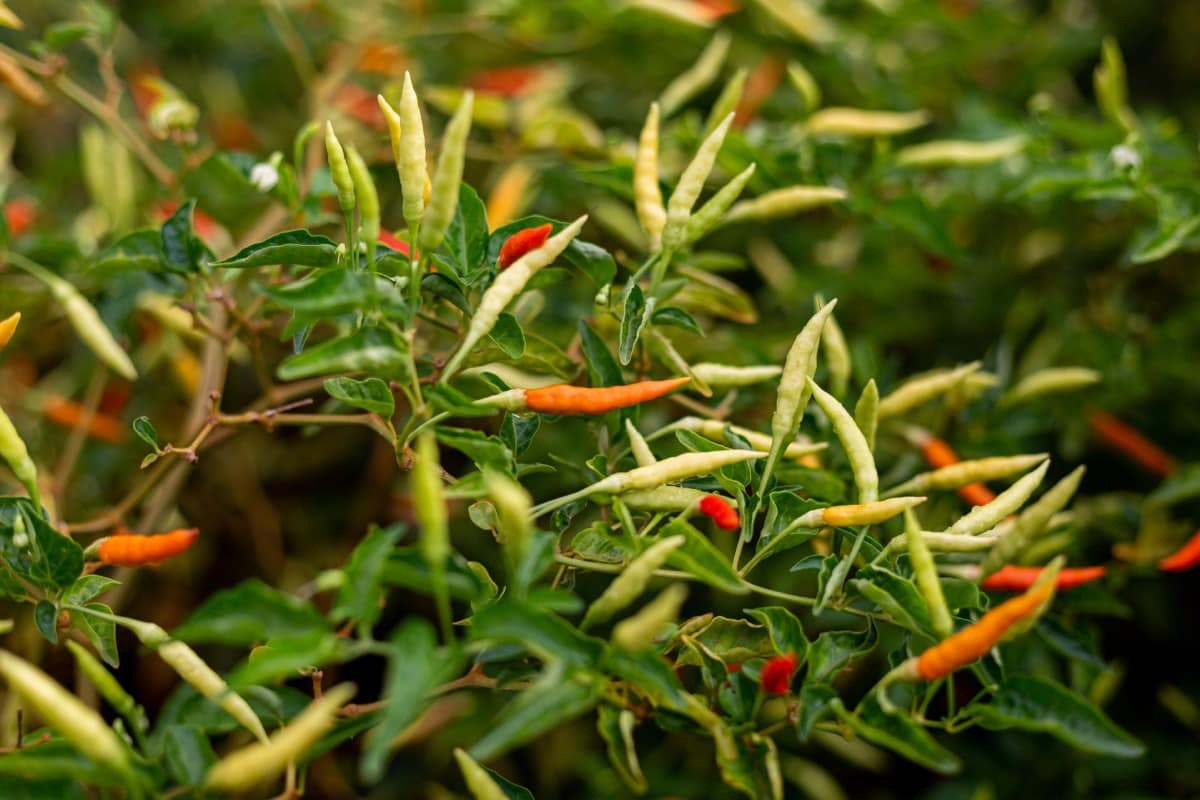
Damage Symptoms of Black Thrips
- Chilli Thrips/ Black Thrips are a common pest that mainly feeds on young leaves, buds, and fruits.
- They cause damage by extracting the contents of individual cells, resulting in the browning, bronzing, or blackening of infested plant parts.
- Feeding scars, distortion of leaves, and discolorations of buds, flowers, and young fruits are common damage symptoms.
- Infested leaves will have elongated petioles, appear silvery, and curl upwards. Infested buds can become brittle and drop.
- Brownish streaks on flower petals are formed because of scraping by adults. The infestation in the early stage could lead to stunted growth.
- It can also affect flower production leading to reduced yield. Both nymphs and adults feed on the underside of young leaves, leading to deformation and premature defoliation of the plant.
- Fruits may also show scabs, spotting, and distortion, reducing market value—infestation peaks during drier months and in soils with excessive nitrogen fertilizer application.
- A severe infestation may lead to complete defoliation and total crop loss.
Yield Loss due to Black Thrips on Chilli
The occurrence of black thrips on chili in India was first reported in 2015. These pests can cause significant yield loss in chili plantations, with potential losses of up to 22.8%. The damage caused by thrips includes large-scale shedding of flowers, malformation of fruits, and fruit drop, which can severely affect the overall yield of the crop.
In case you missed it: Sucking Pests in Chilli Crop: Symptoms, Causes, Control, and Treatment

Black Thrips Management in Chilli by Cultural Method
- Cultural methods are effective in managing black thrips infestations in chili.
- Intercropping with agathi Sesbania grandiflora provides shade that regulates the thrips population.
- It is advisable not to grow chili after sorghum, which is more susceptible to thrips.
- Avoid mixed cropping of chili and onion, as thrips attack both crops.
- Sprinkling water over seedlings can help to check the multiplication of thrips.
- These cultural methods can help reduce thrips infestations and, thus, minimize the damage caused to chili crops.
Black Thrips Management in Chilli by Biological Method
- Biological control is an effective and eco-friendly method for managing black thrips in chili.
- Predatory thrips, green lacewings, minute pirate bugs, mites, and certain parasitic wasps can help control plant-feeding thrips.
- To encourage the naturally occurring population of these beneficials, avoid persistent pesticides and grow a diversity of plant species.
- Different thrips have specific natural enemies that are important for their control.
- For instance, Macrotracheliella nigra and green lacewing larvae are important predators of Cuban laurel thrips. Euseius species mites are important predators of citrus thrips.
- In 50% of greenhouse thrips, eggs are killed by Megaphragma mymaripenne, a tiny wasp.
- Thripobius semiluteus parasitizes greenhouse thrips larvae, leading to their swelling and turning black.
In case you missed it: How to Control Western Flower Thrips in Chilli Crop: Identification, Fact Sheet, Chemical and Biological Management

Black Thrips Management in Chilli by Chemical Method
- Chemical methods can also be employed when it comes to controlling black thrips in chili. Several best effective chemical controls/ Insecticides are available in the market to kill thrips and other sucking pests.
- Keefun Insecticide, for instance, is made of Tolfenpyrad, which has an anti-feeding mode that immediately stops the pests from feeding upon contact.
- Similarly, Delegate Insecticide, made of Spinetoram, can provide long-term effects in controlling thrips and other pests without harming beneficial insects.
- Gracia Insecticide, which belongs to the isoxazoline class, is another effective chemical control that can be used against black thrips. It contains Fluxametamide, a translaminar insecticide effective when ingested or through contact.
- Exponus Insecticide, containing Broflanilide, is another effective tool to control insects that are difficult to control, especially black thrips.
- EM 1 Insecticide, containing Emamectin Benzoate, is another chemical control that can effectively control black thrips. It exhibits translaminar action that helps control thrips on the lower leaf surface. The residue of this chemical is low, making it suitable for use in Integrated Pest Management (IPM).
- Seed treatment with imidacloprid 70% WS at a rate of 12 g/kg of seed.
- One option is to apply carbofuran 3% G at a rate of 33 kg/ha or phorate 10% G at a rate of 10 kg/ha.
- Insecticides can be sprayed directly onto the crop foliage. Thiacloprid, 21.7% SC, can be sprayed at a rate of 6.0 ml/10 lit, while Imidacloprid 17.8% SL can be applied at a 3.0 ml/10 lit rate.
- Dimethoate 30% EC can be used at a rate of 1.0 ml/lit, Emamectin benzoate 5% SG at a rate of 4 g/10 lit, Fipronil 5% SC at a rate of 1.5 ml/lit, and Oxydemeton-Methyl 25% EC at a rate of 1.0 ml/lit.
- Several other insecticides, such as Alanto, Osheen, Benevia, Largo, Jump, Regent, Pegasus, and Danitol, can also control black thrips.
- However, the dosage required for each insecticide may vary, and following the instructions on the product label is crucial.
In case you missed it: Top 18 Steps to Boost Chilli/Pepper Yield: How to Increase Production, Quality, and Tips
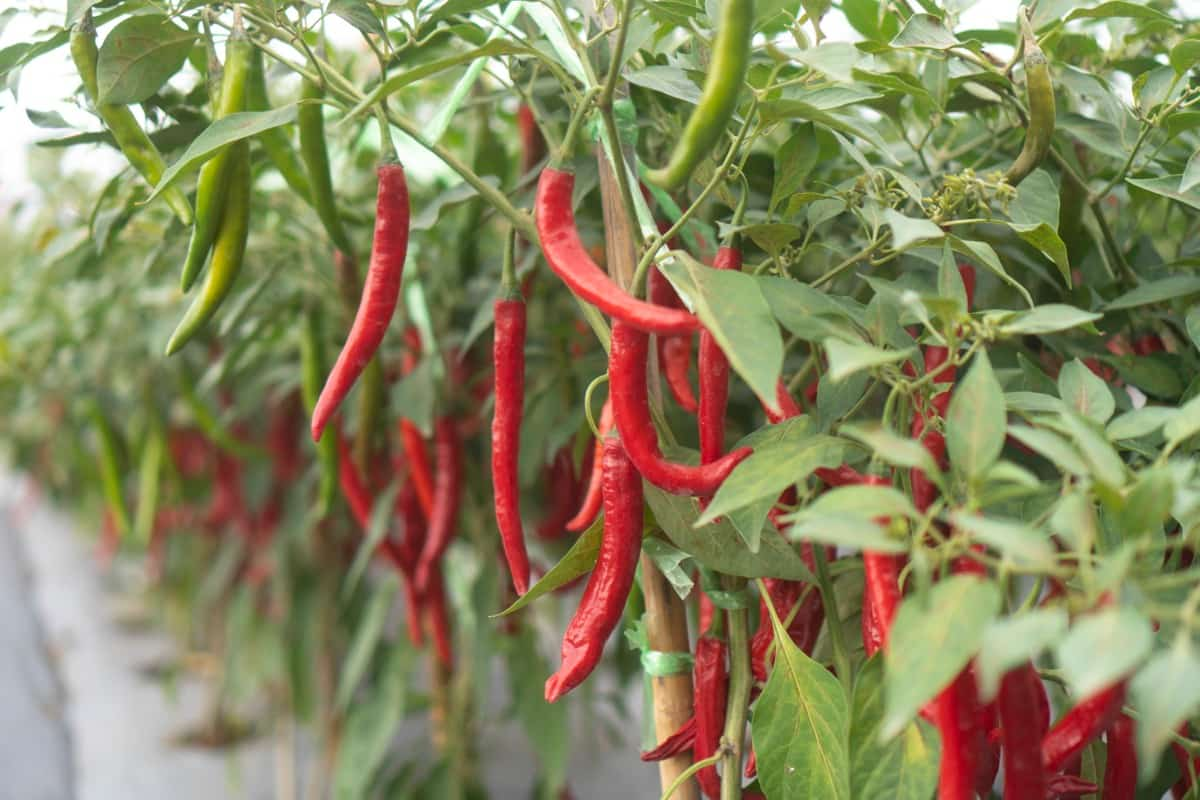
Black Thrips Management in Chilli by Organic/Natural Method
- Black thrips can also be managed using organic and natural methods, which are safe for the environment, humans, and beneficial insects.
- Neem Oil: It is one of the most popular natural remedies for controlling thrips. It contains azadirachtin, which has insecticidal properties. Dilute 5 ml of neem oil in 1 liter of water and spray on the plants.
- Garlic and Onion Spray: Garlic and onion have natural insecticidal properties and can be used to control thrips. Crush a few cloves of garlic or onion and soak them in water overnight. Strain the mixture and add a few drops of dish soap to it. Spray this mixture on the plants.
- Hot Pepper Spray: Hot pepper spray is another effective natural remedy for controlling thrips. Mix two tablespoons of hot pepper sauce with 1 quart of water and a few drops of dish soap. Spray this mixture on the plants.
- Soap Spray: Soap spray can control thrips by suffocating them. Mix one tablespoon of liquid soap with 1 liter of water and spray on the plants.
- Diatomaceous Earth: It is a natural powder made from the fossilized remains of diatoms. It is effective against thrips by cutting their exoskeletons and dehydrating them. Sprinkle diatomaceous earth on the plants and soil.
- Companion Planting: Certain plants, such as marigolds, can be a natural repellent for thrips. Plant marigolds near your chili plants to deter thrips.
- Sticky Traps: Sticky traps can be used to trap thrips. Hang blue sticky traps near your chili plants to catch thrips.
Preventive Measures for Control of Black Thrips
- Intercropping: Practicing intercrop with agathi, maize, or sorghum provides shade to the growing crops, thereby reducing thrips growth.
- Border crops: Growing 2-3 rows of border crops like sorghum or maize can minimize the movement of thrips from adjacent fields.
- Trap crops: Planting trap crops like marigolds between the fields can reduce damage.
- Crop rotation: Avoid growing chili right after sorghum; mixed cropping with onion and chili is also not a good practice.
- Watering: While watering the seedlings, sprinkle the water, reducing thrips multiplication.
- Sticky traps: Install blue, yellow, and white sticky traps at crop height to help mass trap thrips.
- Neem oil: Spraying of neem oil (10000 ppm) at 2 ml per 1 liter of water acts on the eggs of thrips and acts as an antifeedant that limits crop damage.
In case you missed it: Organic Chilli Cultivation (Peppers/Mirchi), Farming Process
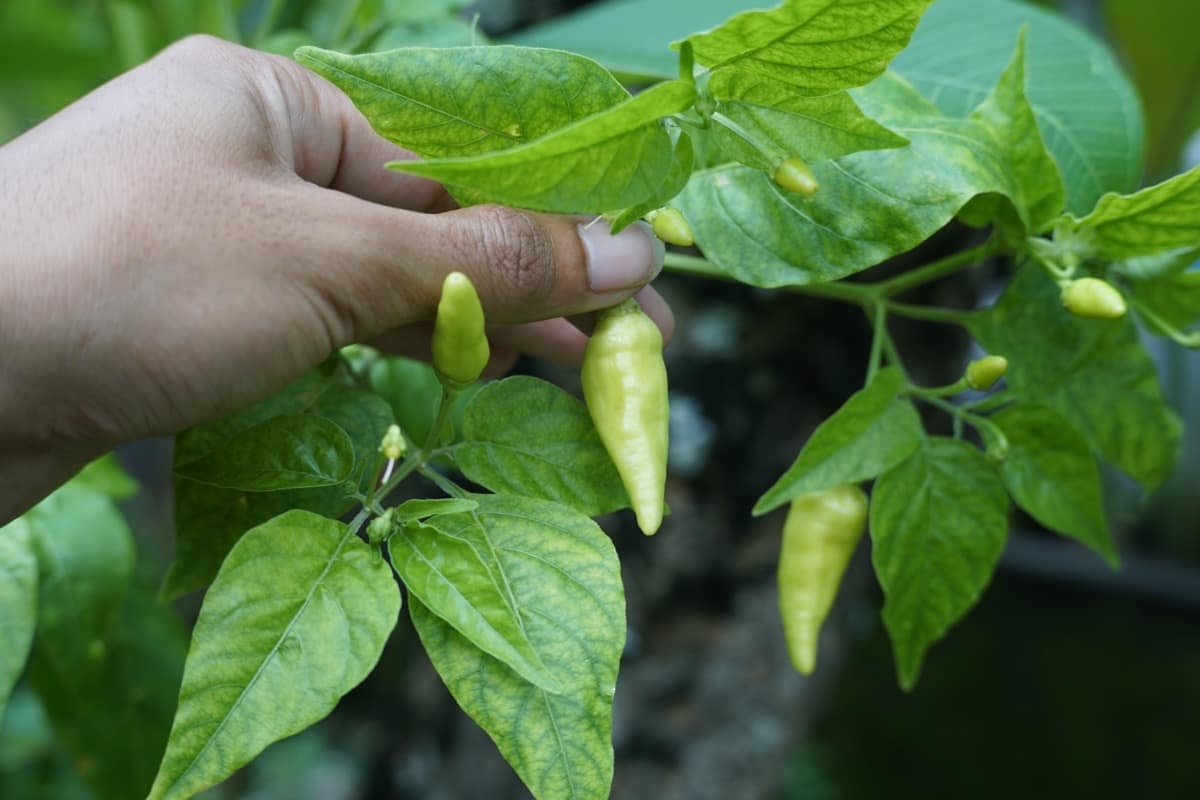
Conclusion
Black thrips infestation in chili crops can cause severe damage and yield loss. Early identification of symptoms and appropriate cultural, biological, natural, organic, and chemical control measures can help manage the pest. Planting trap crops, intercropping, sticky traps, neem oil sprays, and natural predators like ladybugs and lacewings are effective methods.
However, chemical control options like imidacloprid, carbofuran, and phorate should be used cautiously, following proper safety guidelines. Combining preventive measures and integrated pest management strategies can effectively manage black thrips in chili crops.
- How to Make Houseplants Bushy: Effective Tips and Ideas
- Innovative Strategies for Boosting Coconut Pollination and Yield
- Pollination Strategies for Maximum Pumpkin Yield
- The Complete Guide to Chicken Fattening: Strategies for Maximum Growth
- Natural Solutions for Tulip Problems: 100% Effective Remedies for Leaf and Bulb-Related Issues
- Revolutionizing Citrus Preservation: Towards a Healthier, Greener Future
- Natural Solutions for Peony Leaf and Flower Problems: 100% Effective Remedies
- Maximizing Profits with Avocado Contract Farming in India: A Comprehensive Guide
- Natural Solutions for Hydrangea Problems: 100% Effective Remedies for Leaf and Flowers
- The Ultimate Guide to Choosing the Perfect Foliage Friend: Bringing Life Indoors
- From Sunlight to Sustainability: 15 Ways to Use Solar Technology in Agriculture
- The Ultimate Guide to Dong Tao Chicken: Exploring from History to Raising
- The Eco-Friendly Makeover: How to Convert Your Unused Swimming Pool into a Fish Pond
- Mastering the Art of Delaware Chicken Farming: Essentials for Healthy Backyard Flocks
- 20 Best Homemade Fertilizers for Money Plant: DIY Recipes and Application Methods
- How to Craft a Comprehensive Free-Range Chicken Farming Business Plan
- Brighten Your Flock: Raising Easter Egger Chickens for Beauty and Bounty
- How to Optimize Your Poultry Egg Farm Business Plan with These Strategies
- Subsidy for Spirulina Cultivation: How Indian Government Schemes Encouraging Spirulina Farmers
- Ultimate Guide to Raising Dominique Chickens: Breeding, Feeding, Egg-Production, and Care
- Mastering the Art of Raising Jersey Giant Chickens: Care, Feeding, and More
- Ultimate Guide to Raising Legbar Chickens: Breeding, Farming Practices, Diet, Egg-Production
- How to Raise Welsummer Chickens: A Comprehensive Guide for Beginners
- How to Protect Indoor Plants in Winter: A Comprehensive Guide
- Ultimate Guide to Grow Bag Gardening: Tips, Tricks, and Planting Ideas for Urban Gardeners
- Guide to Lotus Cultivation: How to Propagate, Plant, Grow, Care, Cost, and Profit
- Agriculture Drone Subsidy Scheme: Government Kisan Subsidy, License, and How to Apply Online
- Ultimate Guide to Raising Araucana Chickens: Breed Profile, Farming Economics, Diet, and Care
- Bringing Hydroponics to Classroom: Importance, Benefits of Learning for School Students
- Ultimate Guide to Raising Polish Chickens: Breed Profile, Farming Economics, Diet, and Care
- Ultimate Guide to Raising Australorp Chickens: Profile, Farming Economics, Egg Production, Diet, and Care
- Silkie Chicken Farming: Raising Practices, Varieties, Egg Production, Diet, and Care
- Sussex Chicken Farming: Raising Practices, Varieties, Egg Production, Diet and Care
- Homemade Feed Formulations for Livestock: Discover Cost-effective Starter to Finisher Feed Recipes
- 20 Best Pig Weight Gain Supplements: Top Swine Weight Gain Formulas
- Ultimate Guide to Elderberry Farming: Propagation, Planting, Yield, Cost, and Profit